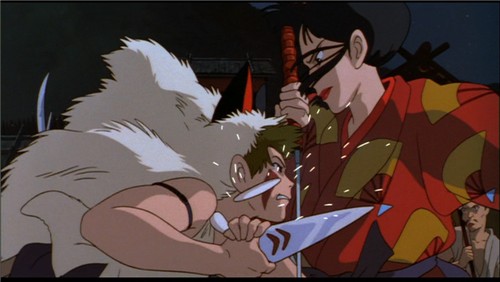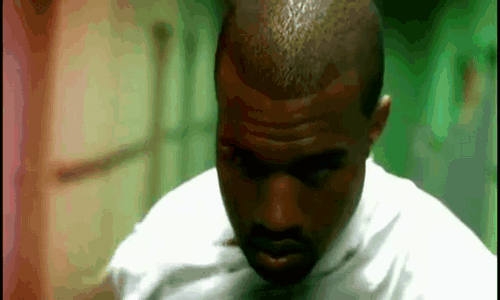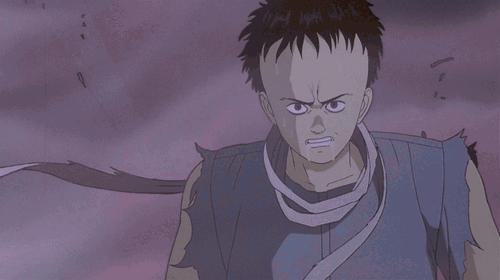Hey, it's Justin and it's all my fault!
So in a pathetic attempt to exonerate my poor pitiful self after finally being added to this blog, I'm gonna start by talking about Princess Mononoke.
One thing that stood out to me in Princess Mononoke is the
portrayal of the battle between nature and humanity without painting either as
the villain. Each side is represented most strongly in the two strong female
characters of the film, the titular “Princess Mononoke” or San, who fights with
the forest and the wolves, and Lady Eboshi, leader of the ironworks and
manufacturer of guns. In a movie emphasizing the protection of nature, San is
an obvious protagonist. Lady Eboshi, while in a position that would normally
paint her as an antagonist, is portrayed as anything but such. She is
reasonable and just, showing kindness to Ashitaka even after he calls her out
for the murder of the pig demon. Furthermore, we are introduced to several
characters from both sides in order to avoid making either seem like the “bad
guy”. Miyazaki has chosen to do this because the film is not intended to be
anti-technology, but instead calling for peace between man and nature. The
scene where Ashitaka knocks out and saves both Eboshi and San during their
heated battle with each other exemplifies the intended neutrality.
Another
thing that stood out to me was the painstaking detail put into the animation of several
demanding shots such as the animation of the demon tentacles at certain points
and the sprouting of flowers and fauna at the feet of the Deer God.
Moving
on to Grave of the Fireflies.
Now that that's out of the way...
I found it interesting how from the very
beginning, it is revealed that the two characters we will be following are
going to die. Why would Miyazaki do this? In my opinion, it is to help the
audience know what to focus on. Knowing the fate of the two characters survival, wondering whether they will die or not, is not the main focus of the film. Rather, we are meant to focus on how they
come to die. The audience is invited to pay attention to Seita’s character
development, from a stubborn kid who leaves the safety of his aunt to go live
in a bomb shelter, so that he can enjoy time with his sister alone, to a boy
who suffers the loss of his beloved sister because he failed to provide for
her.
It
is also important to note that while the film is meant to present the harsh
effects of war on people, Seita and Setsuko are presented as maintaining their
childish innocence throughout the war. They are carefree, playing and enjoying
themselves while others are shown working hard and getting supplies. While they
are at the beach, we see them frolic in the waters, juxtaposed with another
person and her child collecting water, staring at them perplexed.
We watch these two and their playful antics with sentimental amusement. In the end however, their innocence, while very endearing and beautiful, results in their downfall and saddening death.
And now to analyze...
...Kanye West's "Stronger" music video.
When I first watched Akira, I was overwhelmed, albeit confused. After some time, I have come to realize that Akira touches on coming of age themes, as well as Japan's technological culture and past. Tetsuo faces a problem typical to many young teenagers, attempting to win respect of his friends, rather than being a constant burden that needs help and rescuing. Kaneda's frequent bossing around of Tetsuo is shown to be harmful to his confidence. Susan Napier ties this in with Japanese culture by stating that, "[Tetsuo's] character actually evokes a less obvious but deeply significant side of Japanese national self-representation, that of a lonely outcast."
However, once he unlocks his extraordinary psychic abilities, he is confused, caught between embracing his powers, and fearing them. Tetsuo's new powers hold parallels to the concept of puberty. He becomes rebellious towards Kaneda, as well as more violent towards all who oppose him, destroying infrastructure and massacring dozens of soldiers. His rebelliousness of course parallels the actual rebellions in Neo-Tokyo against the corrupt government, though he himself never actually participates in the revolution.
Eventually, he loses control of himself and becomes a monster. His aggressive rage ends, and he starts begging Kaneda for help rather than bullying him as he did earlier. Eventually, with the help of the espers, the three psychic children, he is reborn as a universe.
So after his whole coming-of-age journey, Tetsuo's salvation comes from the aid of some children, and being reborn again? Perhaps the movie is saying that in order to save and control ourselves, we must return to our youth before our corruption by society. But that's just a hypothesis.
And that's it. Bye.















Hello , how about you one Following of princess mononoke ?
ReplyDeleteMr MIYAZAKI 's uncontested masterpiece leaves us mouthwatering and with a taste of a work still to be finished . Many a questions raised as the story unfolds itself remains without answers while they constitute the backbone of the whole plot . Once you have been aware of those issues ,you'll go deeper into Miyazaki's masterpiece.Being familiar with thos issues will enable you to go deeper into this story. Watch this video and give me your opinion
www.youtube.com/watch?v=1LgkwYTygRY&feature=youtu.be